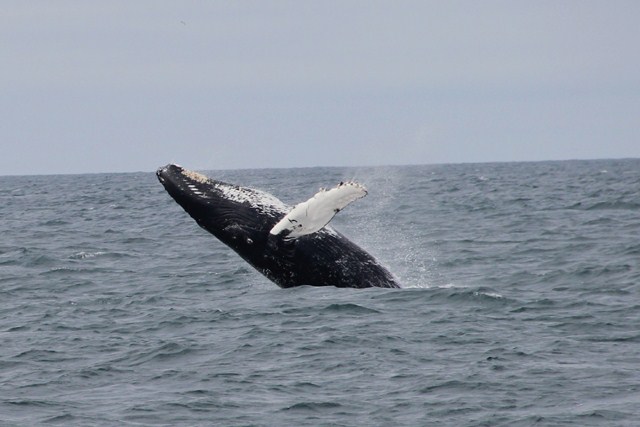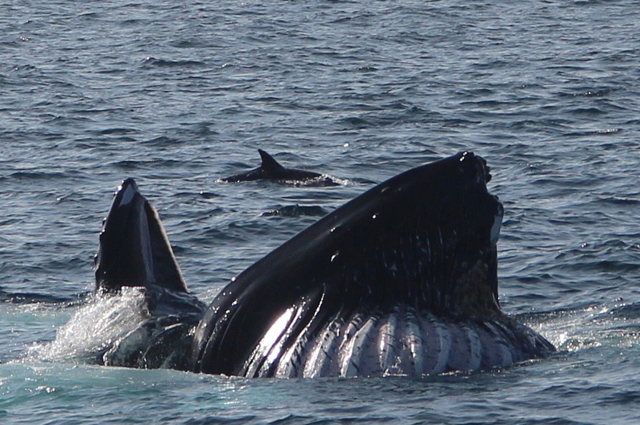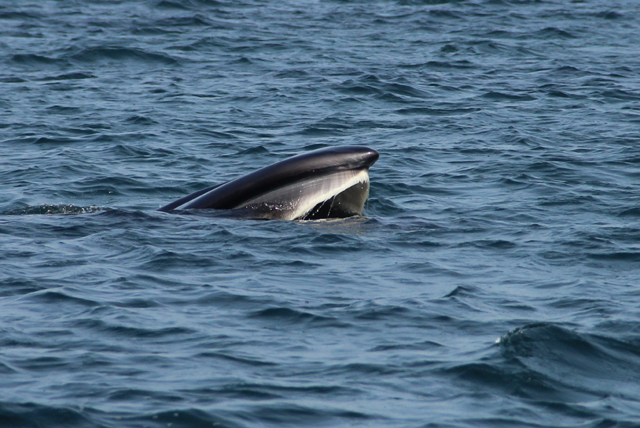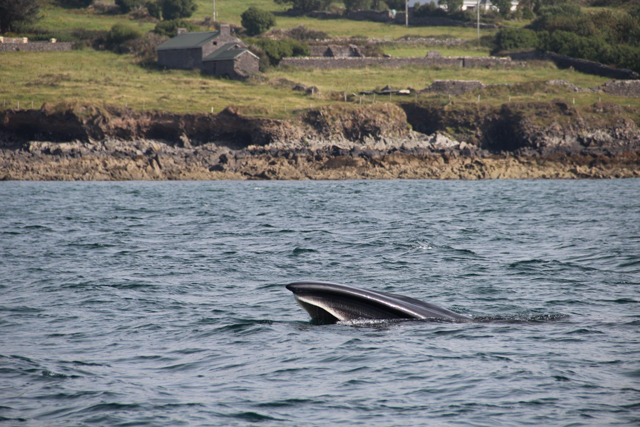Dolphin and Whale Watching Season Ireland 2014

Humpback HBIRL24 breaching off Blasket Islands, Kerry

Humpback HBIRL17 bubblenetting -with common dolphin for scale...

Sei whale off Ventry pier, Co Kerry, showing diagnostic dark right baleen

Sei whale skim-feeding in Ventry Harbour - note the typically downturned rostrum (nose) for this species
All pictures copyright of Britta Wilkens
Video
Dolphin and whale watch season 2014 Blasket Islands / Dingle Bay, Co. Kerry, Ireland south west
Our 2014 dolphin and whale watch season got off to a good start when on our first tour in April we came across a school of 25 bottlenose dolphins in the Black Sound. They had been recorded a few days previously off the northwest coast and we regarded them as a good omen for the start of our season.
Later in the summer we had a similar but more extended encounter as a school of bottlenose dolphins accompanied us all the way from outside Ventry Harbour to Slea Head on the morning cruise till we left them as they continued on south of the Great Blasket island. On the afternoon eco marine tour we met them again just east of Inish Tuaisceart - "The Sleeping Giant" or "The Dead Man" [" An Fear Marbh" in Irish] and they again engaged with us, breaching and diving around the boat to the delight of our passengers until they decided to cotinue on their journey north.
Marine wildlife viewings all through the months of April and May were nothing short of spectacular with plentiful schools of common dolphins almost every trip, lots of Minke whales and also lots of basking shark surface feeding on plankton. The water was murky with the amount of plankton and also there was an abundance of sand eels early in the season which was in complete contrast with the dearth of sand eels later in the summer. I looked out of the wheelhouse window of "Blasket Princess" one day in the middle of the Blasket Sound and thought - "This is like doing a marine tour in an Aquarium" - the water was so thick with common dolphins, Minke whales, basking shark and even the occasional grey seal. Happy Days! for customers of Blasket Islands EcoMarineTours and ourselves!
This period of plenty was followed by a very blank period probably caused by an exceptionally dry calm summer with no consequential appreciable nutrient rich water runoff from the land into the sea; no major storms or gales to help mix up the water layers to disturb the water stratification between different water temperature zones; and generally typified by a lack of plankton in the water and sparse, dispersed occurences of sand eels. Luckily for Blasket Islands EcoMarineTours we always have the grey seals hauled out on Carraig Fhada to show our visitors and, at least until the end of July / beginning of August, plentiful rafts of puffins on the water by the outer Blasket islands and nesting in the sea cliffs there. Basking shark made a brief appearance for about 4 weeks, numbers slightly down on previous years and then, always surprisingly, they left just as quickly and unexpectedly as they came.
Humpbacks breaching, bubble netting and even doing the backstroke!
The monotony and calmness of midsummer was broken by a big splash up north - "Charlie"! officially HBIRL17 - the humpbacks were back!
This year, even more so than usual, the humpbacks stayed quite a distance offshore, apart from a few memorable moments enjoyed by ourselves and our passengers, and it appears that perhaps strong tidal streams [ particularly at "Spring" tides] offshore from the Blaskets [ the most westerly archipelago of islands off mainland, continental Europe] and the resultant turbulance around underwater seamounts, created enough disturbance of sea bed nutrients to encourage plankton blooms with accompanying zooplankton and krill which in turn led to small concentrations of sprat on which the visiting migratory humpbacks were feeding.
It is difficult to confirm this food source for sure, as despite their annual returning presence over the last few years to the waters of West Kerry, south west Ireland, there is no scientific based research being done into their food source and as a result of course no protection, provided for their food source, especially if it is sprat, as we think, which is a non quota species in Ireland. This important food source for migratory cetaceans needs protection in Ireland, right now*, instead of being unsustainably fished by a small number of large trawlers for fishmeal and sold for €100 per ton! But the food source for these visiting humpbacks [ 4 to 5 months off Kerry coast depending on the year and abundance or lack of food supply] needs to be officially and scientifically identified before measures can be taken to protect it.
Unfortuately- for the humpbacks- the authorities wont just take the word of Captain Whales Galore you know! But aren't there two International Conventions, which Ireland has signed up to, which protect the habitats and food sources of Internationally Protected Migratory Species? These are the Berne Convention on Conservation of European Wildlife and Natural Habitats (Appendix II and III) and the Bonn Convention on the Conservation of Migratory Species of wild Animals (Appendix I and II).
Cetacean sighting(s) of the 2014 whale watch season, Kerry, Ireland south west
I would have said watching humpback "Charlie" doing the backstroke with his massive (1/3 body length) pectoral fins was the highlight of our dolphin and whale watching season, but on reflection, observing and positively photo identifying a Sei whale (Balanoptera borealis) in Ventry Harbour approx. 50 metres from our mooring buoy from which we depart for our whale watching boat trips was a major highlight of our whale watch season.
We had previously observed, on two different occasions, what we assumed to be a Sei whale in Dingle Bay but our sightings reports were not accepted by IWDG sightings officer because they were not accompanied by photo I.D. As far as we were concerned if the initial cue was a distinctive blow, if size was approx. half way between a fin whale and a Minke whale, if it was skim feeding along the surface of the water and blowing regularly and swimming fast, chances were it was a Sei Whale!
Later when the Sei whale followed our whale watching boat into Ventry Harbour and was scooping up small shoals of krill on which sprat were feeding just off the beach we were able to recognise and photo id the diagnostic uniformly dark coloured baleen and rounded rostrum and lack of any white patches on pectoral fins [Minke whale] or white right jaw [fin whale].
Anyway, the record is straight now, and let's hope for many more confirmed Sei whale sightings next whale watch season 2015, now that the credibility doors are open to Sei whale sightings reports in Ireland.
This sighting of what is a rare whale in Irish waters (now) has really whetted our appetite for next 2015 whale watching season and we intend to do some specialist trips about 15 / 20 miles offshore in late May / early June, when both Northern right whales [Eubalaena glacialis] and Sei whales were traditionally seen off the Irish coast in the bad old whale huntin' days. The favourite food of both species appears to be the miniscule ( 3 - 4 mm.) crustacean like copepod Calanus finnmarchicus which is plentiful in the mesozooplankton biomass in late Spring / early Summer off the west coast of Ireland when this tiny copepod is present in huge "swarms" feeding on vast "blooms" of phytoplankton. We hope to have more information for you about rare whales in Irish coastal waters at the end of our next 2015 whale watching season!
*
Sprats ( Sprattus sprattus) are an inshore species traditionally fished by small boats from November to February from the mouth of the Shannon to Hook Head but now targeted by sonar and scooped up by large trawlers when E.U. quotas for herring and mackerel are filled. They appear to be the main prey / food source of migratory humpback whales off the south west and south coasts of Ireland from mid Summer to early Spring as the whales migrate south (or south west, yet to be determined) towards their breeding grounds. "There are no current management regulations for sprat in Ireland" [B.I.M.] - unlike in the U.K. A regime needs to be put in place urgently for sprat fishing in Irish waters that saves the remaining dispersed shoals of sprat that are prey species for herring as well as humpback whales, while at the same time compensating fishermen for lack of earnings for not fishing for the species until a proper management system is put in place. At €100 per ton projected earnings this would not be an expensive precautionary measure to put in place.
This management system needs to take account of the whole marine eco system all the way from the most productive areas of zooplankton on which the sprat feed, and the herrings and humpbacks and other species including sea birds which feed on the sprat.
In this respect it appears that there is no reason why fishermen on the sea should not be treated in equal esteem and in parity with farmers on the land in their role as protectors of the environment and there is now a (European) legal precedent, which the fishermen should also be given, of payment in return for protecting and enhancing the environment. At least 10% of our E.E.Z. - European Economic Zone - extending up to 200 miles offshore should be protected, and this will never realistically be achieved unless the fishermen get a "cheque in the post" like the farmers and thus become proactive protectors of the marine environment. As apex predators, Homo sapiens would be very stupid ( contrary to the classification nomenclature) to destroy the eco systems that provide the most basic food sources, which are not inexhaustible, and which because of modern detection and fishing techniques now need a managed, sustainable approach. A healthy marine eco system will provide healthy and plentiful fish stocks and healthy and wealthy fishermen, if managed properly.
It's time that the fishermen took the upper hand in the debate and looked for parity of esteem at European level with the Agricultural sector in being rewarded for protecting and enhancing the marine environment, and are given equivalent financial compensation for any reduction in intensive fishing effort and temporal and / or spatial set aside of fishing zones for rejuvenation of stocks - not just the commercial fishing stocks but also the food sources and eco systems of these stocks e.g. krill, sand eels, sprat etc)
This may be the subliminal message that the humpbacks revisiting the Irish s.w. coast over the last number of years may be trying to give us!
It will be a big step in the right direction to start with a management plan for the remaining (small) stock of sprat left in Irish waters!















